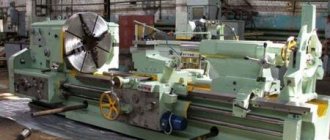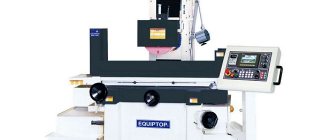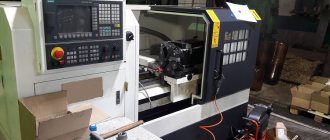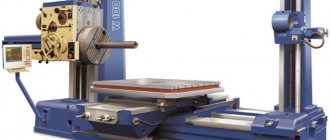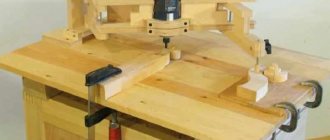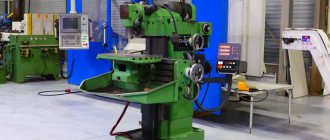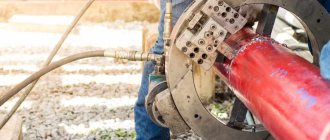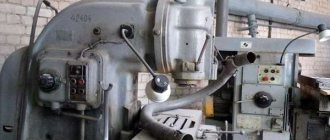- With replaceable gears, provide a large count. feeds limited by range. Used in dilapidated settings.
- With movable wheels. Used for frequent rebuilding of universal machines.
- With counter cones and draw key (easy control, 8-10 steps). Used in drilling lathes and turrets.
- Norton boxes (transmission with ring wheel).
- Guitar-shaped interchangeable wheels. They allow you to adjust the feed with any degree of accuracy (Umin=1/8).
- The Meander mechanism is a three-shaft mechanism consisting of a series of 2-wheel blocks with a ring gear. Advantage: single lever control, small axial dimensions.
Classification methods
Screw-cutting lathes are divided into several types. There are several most popular characteristics by which machines of this type are classified.
Weight
There are small machines that are convenient to use in a personal workshop or large ones that are intended for industrial production.
Large and heavy turning devices are mainly intended for use in mechanical engineering and energy. Heavy machines – over 40 tons in weight.
The lightest ones weigh no more than half a ton. Each type of mass has its own characteristics:
- Lungs. As a rule, the cross-sectional diameter in such equipment is no more than 500 mm.
- Machines weighing up to 15 tons are considered medium and they do not process parts with a diameter greater than 1250 mm.
- 15-400 tons. Rarely found with high accuracy rates. Typically this is Class H equipment.
Maximum part length
This parameter is determined by the distance between the centers of the machine. With equal diameters of manufactured products, there are machines capable of processing long and short workpieces.
Max diameter
According to the maximum diameter, there is the most extensive classification of parts. They start from 100 mm and go up to 4000 mm. In addition to the above indicators, a parameter such as productivity is often used for classification.
There are machines for small-scale production, for medium-scale production and for large industrial scales. The latter option is used on conveyor lines.
Overview and diagrams of common models
Among the diverse model range and several generations of machines that are produced by our production, there are several models that continue to be popular for their technical characteristics and universal properties.
All of them are used in production or in domestic conditions to this day. At the same time, they continue to be worthy competitors to foreign analogues.
These are reliable, durable and durable devices capable of performing a huge number of different functions.
1L532
One of the most popular machines in the former USSR, which can successfully process workpieces of medium and large sizes.
At one time, this equipment was successfully exported to many countries around the world. Accuracy class – N. Machine weight – 43 tons.
16U04P
High precision equipment. The largest diameter of the part processed above the bed is 200 mm. Machine weight – 750 kg.
1P611
A machine used in production, including for turning wheels of railway vehicles. According to GOST, they are distinguished by increased accuracy and have the ability to brake the spindle. Device weight 560 kg. Easily performs the following functions:
- Drilling.
- Segment.
- Cutting internal and external threads.
- Treatment of various surfaces.
The largest diameter of the workpiece above the bed is 250 mm.
1D601
This machine is better suited for purely domestic use. The accuracy is lower than the previous machine. It features high performance even after many years of operation.
Moving the caliper is only possible manually. The weight of the entire machine is about 30 kg. Due to the small dimensions, the maximum length of the workpiece to be processed is 18 cm.
16K40
One of the most popular models that has really gained popularity among craftsmen. Belongs to the middle class of equipment with accuracy class N.
Since 1932, several tens of thousands of various screw-cutting lathes have been produced in the USSR. They were used not only in production, but also for training young people, in schools, colleges, and many had desktop machines in garages, homes, and their own workshops.
Such equipment will help to bore a hole, level the required surface, or drill an existing hole. It is important, focusing on the initial specifications of the equipment, to purchase the most suitable model.
Purpose and scope of application of a universal metal machine
Parts processed by universal screw-cutting lathes are mainly made of ferrous and non-ferrous metals.
Turning cones and threading are additional functions of the machine. If the kit includes additional tools and drills, then the functionality of the machine is even greater.
Since these machines have large dimensions and impressive weight, they can rarely be found in private workshops. Areas of application:
- production of small series of products;
- single production and processing of parts;
- in rare cases - mass production.
But on an industrial scale, screw-cutting lathes are rarely used.
Repairing the headstock housing of a lathe
Restoring the holes for the spindle rolling bearings by boring and then pressing the bushings into the headstock housing is done in rare cases when there is significant wear on the holes, which cannot be compensated by appropriate adjustment of the bearings.
Provided that the spindle bearings are installed in special housings (machines) and flanges, the wear of the bearing holes is compensated by replacing the corresponding housings and flanges, followed by adjusting the internal diameter to the bearing and adjusting the radial runout (permissible deviation 0.01 mm).
When restoring holes by boring and installing compensation bushings, the headstock housing is repaired as follows.
Initially, use a scraper to clean the burrs on the supporting surfaces 8 and 10 (Fig. 59, o) of the headstock housing 3 and in the holes for bearings 1 and 4. Then the worn hole is bored (in our case, the hole of the front bearing 4) on a horizontal boring machine 6 for subsequent pressing of the bushing.
The headstock body is installed on the table 9 of a horizontal boring machine with supporting surfaces 8 and 10. The installation accuracy is verified using indicators 2 and 5 on the mandrel 7 fixed in the spindle of the boring machine (the spindle axis must be parallel to the supporting surfaces 8 and 10). The installation is aligned using the undeveloped surfaces of holes 1 and 4 (permissible deviation 0.05 mm along the length of the part, installation accuracy 0.01 mm).
After securing the headstock body of the lathe to table 9 of the horizontal boring machine, the worn hole is bored to press in the bushing, and the inner size of the bushing should be taken with an allowance for boring, and the outer diameter of the bushing should be equal to the inner diameter plus 15-16 mm (permissible deviations: radial runout - no more than 0.01 mm; non-parallelism of the hole axis to the supporting surfaces 8 and 10 of the headstock base - no more than 0.01 mm over a length of 300 mm).
After pressing in bushing 1 (Fig. 59, b), it is necessary to bore it and trim the end to press in the bearing (permissible deviation - radial runout - no more than 0.01 mm).
The headstock housing is installed on the repaired frame guides and the correct installation and scraping of the supporting surfaces 8 and 10 are verified (Fig. 59, a). Then, control mandrel 1 is inserted into the conical hole of the spindle (Fig. 59, c) and using indicator 3 installed on bridge 2, the parallelism of the spindle axis in the horizontal and vertical planes is checked, while the bridge with the indicator is moved along the frame guides along the length of the mandrel.
If there are deviations above the permissible ones, the defect is eliminated by scraping the base of the body (supporting surfaces) of the headstock.
Non-parallelism of the spindle axis is allowed: in the vertical plane, the free end of the mandrel can only be above the horizontal axis (0.02 mm over a length of 300 mm); in the horizontal plane - no more than 0.02 mm over a length of 300 mm, and the free end of the mandrel can only be deflected towards the cutter.
After scraping, the number of paint prints should be at least 10 on an area of 25 X 25 mm.
To repair the headstock guides, it is necessary to install the spindle in its supports (bearings). The headstock with the spindle is placed on the frame guides, aligned to the level, and a control mandrel is inserted into the conical hole of the spindle (Fig. 59, c). A stand with an indicator 3 is installed on the caliper carriage or on the universal bridge 2, the measuring pin of which is sequentially brought to the upper and side generatrices of the mandrel. Then, deviations from parallelism are determined when the carriage moves along the bed guides. The guides are scraped according to the paint prints, taking into account the deviations noted on the control mandrel. The number of paint prints must be at least 10 on an area of 25 X 25 mm. Non-parallelism in the vertical plane is allowed no more than 0.02 mm over a length of 300 mm. The free end of the mandrel can only be tilted upward. Non-parallelism in the horizontal plane is allowed no more than 0.01 mm over a length of 300 mm. The free end of the mandrel may deviate towards the cutter.

